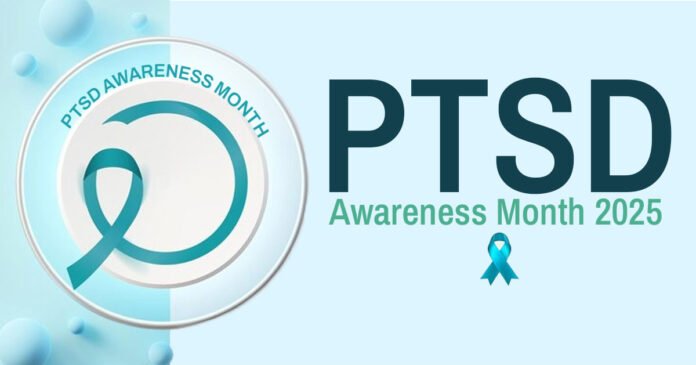Post-Traumatic Stress Disorder (PTSD) is a mental disorder that can of any person who has gone through a traumatic experience. It is one of the conditions that may be unnoticed or misunderstood, even though it has a great influence on human lives.
Similarly, raising awareness about PTSD is essential in making people know the signs and symptoms, together with the ways of supporting the victim. In this blog, we will discuss PTSD awareness, its color, and its symbol.
What is PTSD?
PTSD (Post-Traumatic Stress Disorder) is another mental condition that occurs in an individual who has experienced some form of trauma. Moreover, war, accidents, or abuse may follow the loss of a close person. This state may cause individuals to be frightened, nervous, and tense, even when they are not in any danger.
In addition, individuals who experience PTSD can experience flashbacks, nightmares, or shun areas that remind memories of the trauma. They may also experience numbness or a lack of connection with their feelings and other people. The symptoms may complicate daily life, including the working environment, relationships, and health.
PTSD Awareness Color
The PTSD awareness color is teal. The color Teal symbolizes mental health battles in general and PTSD in particular. By using teal to create awareness of PTSD, one contributes to raising awareness about the condition, and it serves as a visual reminder to aid the victims.
Furthermore, in numerous elements of an awareness campaign, such as ribbons, clothing, and posts on social media. So, teal is put into action in order to increase awareness of PTSD. Thus, wearing teal or wearing the teal ribbon at the events of awareness is one of the ways to normalize the discussions about PTSD. So, it helps to decrease stigma and support people who face this mental health condition.
The PTSD Awareness Symbol
The ribbon of PTSD awareness is the teal ribbon. The teal ribbon symbolizes support for the PTSD population and people representing various causes. It is an easy and yet strong visual piece that reminds people about holding the conversation on PTSD. It is promoting adequate treatment, and demonstrating compassion towards the people who are experiencing hard mental health challenges.
Additionally, the ribbon is meant to show how it is essential to support the experience of trauma survivors and help them heal. Working to get rid of mental health stigma reminds us of the need. Many organizations also wear the teal ribbon to create awareness about PTSD throughout the year and specifically during PTSD Awareness Month in June.
Why Is PTSD Awareness Important?
1. Reducing Stigma Around Mental Health
Similar to other mental health disorders, PSTSD is usually stigmatized. The awareness of PTSD can do a lot to eliminate this stigma by helping to discuss mental health openly. Do not view this health condition as a lifetime taboo, like any other disease.
2. Encouraging Early Intervention
The problem of PTSD is misconceived, and lots of people can be unaware of the signs and symptoms. This may result in late treatment of the condition, which complicates its management of the condition. Therefore, better knowledge will enable the population to recognize the initial symptoms of PTSD and consult a healthcare provider. It is due to prevent the development of a more severe health complication.
3. Promoting Education and Support Systems
Learning about PTSD is vital to the sufferer and his or her friends and relatives. PTSD awareness makes one aware of the disorder and how it affects the life of an individual, making it easier to support. Education also enables the family members, friends, and colleagues to be empathetic and supportive.
4. Providing Resources for Treatment
Unawareness may make people unable to seek the help they require. PTSD awareness programs. These give information about resources available (including therapy, support groups, and hotlines). Therefore, people can easily access the treatment and assistance when they need it most.
5. Advocacy for Better Mental Health Services
The awareness campaigns also promote better mental health care policies and more resources to sufferers of PTSD. Such campaigns may persuade policymakers to set up funds to treat PTSD programs, to conduct research, and provide services to assist the individuals in restoring their lives.
PTSD Awareness Activities
1. PTSD Awareness Activities
One of the activities that can be done for the cause is getting involved in awareness building concerning PTSD. Are you creating awareness using social media, events, or reaching the local community? Whatever you do matters. The following are the activities you can join or arrange to create awareness of PTSD:
2. Wearing the Teal Ribbon
As pointed out, the teal ribbon is a simple and effective way, according to the earlier mentioned. It is a small action that can be put on any time of the year or even a select few events on PTSD awareness (such as the National PTSD Awareness Day on June 27th).
3. Raising Money for PTSD Organizations
Most of these organizations, including the PTSD Foundation of America and the National Center of PTSD, depend on donations to further their crucial operations. To raise funds to support people with PTSD, as well as research efforts, hosting a fundraising event.
4. Training Seminars and Workshops
Another excellent method of raising awareness is to have or attend seminars, workshops, and webinars regarding PTSD. Such events provide a chance to be informed about the condition, exchange experiences, and get to know what can be done effectively to treat the condition.
The PTSD awareness walks or runs are organized by various communities aiming to raise awareness about PTSD. Such events are not only fundraising events but also unifying the community to show that they are in solidarity with those who have to grapple with PTSD.
5. Working with PTSD Support Groups
The awareness campaigns also promote better mental health care policies and more resources to sufferers of PTSD. These campaigns may persuade policymakers to set up funds to treat PTSD programs, to conduct research. It provides services to assist individuals in restoring their lives.
6. Spread the Word Locally
Hold some informational sessions, place some educational flyers in your locality, or collaborate with the local communities to disseminate the message about PTSD. Raising awareness in the area can be useful to individuals who are already struggling yet might not be in a position to seek assistance.
End Note
To sum up, PTSD Awareness is a vital part of the process of comprehension and helping individuals struggling with this mental illness. It contributes to the decrease in stigma and promotes the discussion of mental health. We can also contribute to acknowledging the victims of PTSD by creating awareness, wearing the teal ribbon, and attending awareness events.
The awareness creation can also motivate people to seek assistance and receive treatment, and they find it easier to manage their symptoms. We should keep on learning and educating others, and collaborate to make the world a place where no one is insensitive to PTSD. To get the valuable insights and details explanations, Mental Behavioral is your go-to option to gain more and more information.
FAQs
What are the most prevalent symptoms of PTSD?
Flashbacks, nightmares, intense anxiety, numbness of emotions, irritability, and avoidance of situations that cause the victim to feel the trauma are the most widespread signs of PTSD. Hypervigilance may also be experienced by people with PTSD, in which they are always on their toes.
Can PTSD be cured?
Although there is no specific cure for PTSD, it can be treated. The appropriate therapy, including Cognitive Behavioral Therapy (CBT), exposure therapy, or medication, can help many people with PTSD cope with their symptoms and live a proper life. Therapy can assist the victims in working through their traumas and learn coping skills.
What can I do to assist a PTSD patient?
In case you have a friend or family member with PTSD, it is worth creating a non-judgmental environment to offer them support. Ask them to consult an expert and give them your full attention, and do not provide them with unwarranted advice. You should not downplay their experience, and you should make them understand that their feelings are good.
What may PTSD do to the daily life of a person?
The influence of PTSD on a person can be significant in their relationships, work, and social spheres. Avoidant behaviors can also be a result of PTSD, including the isolation of friends and family.
How can I increase awareness of PTSD in my society?
Education and empathy are the best methods to create awareness. Disseminate knowledge on PTSD, sport the teal ribbon, organize awareness activities, or participate in social media campaigns.
Important Note: This article is for informational and educational use only. It’s not medical advice or a substitute for a psychiatric evaluation. For help and treatment, please talk to the licensed professionals






